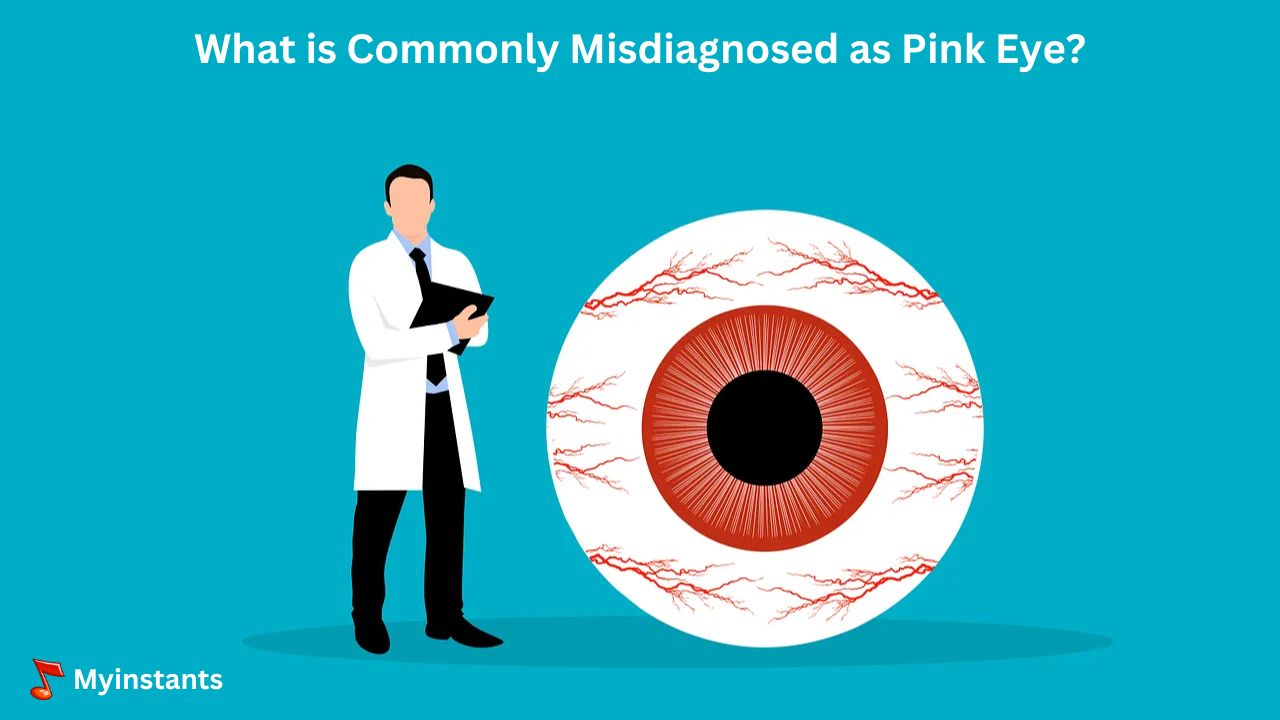What is commonly misdiagnosed as pink eye? You are probably familiar with pink eye, also known as conjunctivitis, as it is a common eye condition affecting over 5 million people yearly. The symptoms of pink eye, such as itchiness, discharge, and redness, also occur in other eye conditions. Well, that’s the reason some eye conditions are misdiagnosed as pink eye.
Pink eye affects the whites of your eyes, turning them red or pinkish. Various reasons can cause it, but for the most part, it is not serious. It usually goes away on its own and doesn’t require a lot of medication except eye drops. However, if you feel extreme discomfort or other symptoms, chances are it’s not pink eye, and you have been diagnosed wrong. In that case, you should consult an eye specialist at once.
In this blog post, we will cover the conditions that look like pink eye but it’s not. So, let’s begin!
What Is Commonly Misdiagnosed As Pink Eye?
Many other eye conditions have symptoms similar to those of pink eye. Thankfully, most of these conditions are non-serious and can be treated at home. However, if you get glaucoma, uveitis, or keratitis, you have a severe problem at hand.
For those wondering, what is commonly misdiagnosed as pink eye? We will provide all the details in this section.
Allergies
Substances like pollen, mold, pet fur, or dust are significant causes of allergies. Coming in contact with these substances might cause allergic conjunctivitis. These things make your body release histamine, which makes your eyes inflamed. It causes symptoms like itching, redness, or burning. You may also get swollen eyelids, runny nose, or watery eyes.
Covid Pink Eye
Some people who get COVID-19 might have red eyes. Research shows that about 1 in 10 non-critical COVID-19 patients in the hospital had this condition.
Dry Eye Syndrome
Another eye condition similar to pink eye is dry eye syndrome. You might have dry eye syndrome if your eyes don’t have enough tears. It can also occur due to poor-quality tear production. Dry eye syndrome makes your eyes irritated and red, which might seem like conjunctivitis symptoms. So, knowing about these similarities and seeing a doctor for the proper treatment is essential.
Keratitis
Keratitis is when the transparent front layer of the eye, the cornea, gets infected, irritated, or damaged. This can cause redness and discomfort in the eye, often mistaken for pink eye due to similar symptoms like blurry vision, eye pain, and sensitivity to light.
Iritis
Inflammation in the middle layer of the eyes, called uveitis, can lead to a condition known as iritis or anterior uveitis. This inflammation explicitly affects the iris, causing symptoms like sensitivity to light, redness, and blurry vision, similar to what you might experience with pink eye. It can happen in one or both eyes and might stem from injury or medical issues.
Stye
Stye, also called a hordeolum, is a small, painful bump on the eyelid’s edge, resembling a pimple. It happens when the tiny oil glands inside the eyelid get blocked by bacteria, leading to infection. Styes can cause discomfort and look like pink eyes, but they are different issues.
Eye strain
Spending a long time staring at a computer, phone, or tablet can dry out the eyes because people don’t blink enough to keep the tear film refreshed. This can lead to redness, dryness, and irritation. To treat digital eye strain, it reduces screen time and makes a conscious effort to blink more often, which is helpful.
Pinguecula
Pinguecula is a yellowish growth on the conjunctiva, often near the inner corner of the eye. It can make the eye irritated, red, and uncomfortable. Excessive exposure to dry, dusty environments or UV lights is thought to be the leading cause of pinguecula. Using steroid eye drops can help ease symptoms.
Episcleritis
Episcleritis is when the episclera, a transparent layer covering the white part of your eye, becomes inflamed. It can happen in one or both eyes and usually causes redness and pain. However, it typically doesn’t affect your vision or cause any discharge.
Chalazion
A chalazion is a bump that forms on your eyelid. It can swell up, become red, and feel tender to the touch, sometimes leading to overall eyelid swelling.
Corneal Abrasion
If your eye gets scratched, which is called a corneal abrasion, it can make your eye red, produce discharge, and be painful. Your eye doctor will determine the best treatment, including antibiotics or steroid eye drops.
Blepharitis
When talking about things similar to pink eye, we must mention blepharitis. When dead skin cells, oily secretions, and bacteria clog the tiny oil glands near the eyelashes, it can trigger inflammation, redness, and itching around the eyelids. This condition is called blepharitis. Its symptoms, such as tearing, redness, blurry vision, sensitivity to light, and crusty buildup on the lashes, may be similar to those of pink eye.
Contact Lens Infections
Eye infections are shared when people don’t care for their contact lenses. For example, if you wear dirty lenses or forget to wash your hands before putting them in, you can introduce harmful germs to your eyes, which might cause bacterial keratitis. You can use antibiotics to treat such infections.
Dacryocystitis
When the glands that make tears get blocked and inflamed, it leads to dacryocystitis. This can cause swelling and infections, especially in the inner corner of the eye. Besides swelling, symptoms might include tearing, discharge, redness, and pain. Antibiotics are often used to treat dacryocystitis caused by bacterial infections.
Foreign body
This term refers to anything that gets into the eye and stays there, like an eyelash, chemicals, speck of dirt, or bits of metal. When this happens, the eye becomes inflamed, producing excessive tears. Flushing the eye can remove the particles, and the doctor may prescribe an antibiotic to prevent an infection.
Pterygium
Pterygium is an unusual tissue growth on the conjunctiva, appearing as a raised pink, red, or white bump. It can cause irritation, redness, and a gritty sensation. Lubricating eye drops can ease irritation and dryness, while steroid eye drops can reduce swelling. Sometimes, pterygium can grow and reach the cornea, affecting vision. If that happens, it needs to be removed through surgery.
Glaucoma
Glaucoma is an eye condition where the optic nerve behind your eye gets damaged, leading to vision problems. You might not notice any symptoms in the early stages, but as it progresses, it can affect your vision. Unlike the pink eye, glaucoma doesn’t make your eyes red or cause any discharge.
Scleritis
Scleritis is inflammation of the sclera, the white part of your eye. It usually affects one eye and shares some symptoms with pink eye, except for the thick discharge. Scleritis pain can radiate from your eye to your jaw, head, and face.
So, these are all eye conditions with symptoms similar to those of pink eye. With a professional, it might be possible for you to distinguish between pink eye and these conditions.
Now that you know what is commonly misdiagnosed as pink eye, you should take proper care of your eyes and consult a doctor immediately.
Also see: Who Was The First Person On Earth? Find The Truth Here
Types Of Pink Eye (Conjunctivitis)
Are there different types of pink eye? Yes, there are! And we are going to cover the details in this section.
There are three main types of pink eye or conjunctivitis. These include:
Viral Conjunctivitis
Viral conjunctivitis often tags along with upper respiratory infection or cold. The main troublemakers are usually adenoviruses. But the good thing is that it usually gets better without treatment. If you consult a doctor, they might prescribe medication or suggest home remedies to help you feel better.
The symptoms include:
- More tears than usual
- Redness in the white part of the eye
- Feeling like your eyes are itching or burning
- A whitish goo coming out of your eye
- Sensitivity to light
Bacterial Conjunctivitis
Bacteria cause this type of pink eye. If it’s not treated, it can harm your cornea. Speaking of which, it is treated using antibiotic eye drops, which your doctor prescribes.
The symptoms are:
- Redness in the white part of the eye
- Thick, yellow gunk coming out of your eye
- Your eyelids sticking together when you wake up in the morning
Allergic Conjunctivitis
This kind of pink eye happens because of allergens like dust mites or pollen. It usually affects both eyes and takes time to heal. To feel better, avoid what triggers your allergies, take over-the-counter allergy medicines, or use special eye drops. If it’s awful, your doctor might prescribe more vital medication to help with the allergy symptoms.
The main symptoms are as follows:
- Your eyes feel itchy and watery
- Your nose might run or feel stuffy
- They might burn a bit
- Sensitivity to light
Also see: Say Goodbye To Sciatic Nerve Pain in Just 10 minutes with this Natural Method
How To Treat Pink Eye At Home?
Dealing with pink eyes at home can be manageable with simple tricks. Before rushing to see a doctor, try these gentle remedies to ease discomfort and reduce inflammation.
- Warm Compresses
There’s nothing quite as comforting as a warm cloth over a sore eye. Applying a warm compress can help relieve the discomfort of pink eye and decrease swelling.
- Keep Your Hands Clean
Good hygiene goes a long way in preventing the spread of infection. Remember to wash your hands frequently to avoid passing the infection to others or reinfecting yourself.
- Lubricating Eye Drops
Dryness and irritation are common symptoms of pink eye. Eye drops formulated to add moisture can relieve and make your eyes feel more comfortable.
- Gentle Cleansing
To remove any discharge from your eyes, gently wipe them with a clean, damp cloth. This can help keep your eyes clean and prevent further irritation.
- Natural Remedies
For a more holistic approach, consider using chamomile tea bags. Chamomile is known for its anti-inflammatory properties and can provide soothing relief when placed on the eyes. A honey mixture and warm water may also offer antibacterial benefits when applied to the affected area.
Also see: What does WYLL Mean? WYLL Meaning, Full form & Usage
When To See A Doctor?
While many minor irritations resolve independently, specific symptoms require prompt attention. Here’s a guide to help you recognize when to contact a healthcare professional.
- Intensity and Duration
Take your time when you experience persistent discomfort, redness, or vision problems. If your conjunctivitis doesn’t improve after 24 to 48 hours, or if it keeps recurring despite treatment, it’s wise to consult your healthcare provider promptly.
- Changes in Vision
Unusual changes in your vision are not typical of pink eyes and should be taken seriously. Ignoring vision changes could lead to permanent visual impairment, so you must seek medical attention if you notice any significant alterations in your sight.
- Pain and Discomfort
Severe eye pain warrants a thorough eye examination. This is especially concerning if accompanied by a headache, fever, or nausea. If you experience these symptoms, don’t hesitate to seek medical assistance.
Final Words
By now, you know what is commonly misdiagnosed as pink eye. You should seek a doctor for proper diagnosis and treatment, whether it’s pink or something else. Instead of dealing with it at home, it is better to go to a professional. After all, your eyes are precious, and you wouldn’t want anything wrong to happen.
Also see: Myinstants – Meme SoundBoard & Sound Buttons
FAQs
How do you tell if it’s pink eye or something else?
The pink eye often causes redness in the whites of the eyes, along with itching, tearing, and sometimes a discharge. If you are experiencing these symptoms, seeing an eye care professional for a proper diagnosis is a good idea.
What illnesses start with pink eyes?
The pink eye is often a symptom of various infections, including viral or bacterial infections, allergies, or irritants like smoke or chemicals.
What virus mimics pink eye?
Adenovirus is a common virus that can cause symptoms similar to pink eye, including tearing, redness, and discharge. It’s a frequent cause of viral conjunctivitis.
Are there other eye infections besides pink eye?
Yes, there are several other types of eye infections. Some examples include styes and keratitis.
What is the fastest way to cure pink eye at home?
You can help alleviate symptoms at home by applying warm compresses to your eyes, cleaning away any discharge, and avoiding rubbing your eyes. Over-the-counter artificial tears may also provide relief.
What does the first stage of pink eye look like?
In the early stages of pink eye, you may notice redness in the whites of your eyes, along with itching, tearing, or a feeling of grittiness. You might also experience a discharge that can be clear, white, yellow, or greenish.
For more such interesting content, keep reading Myinstants Blog.



